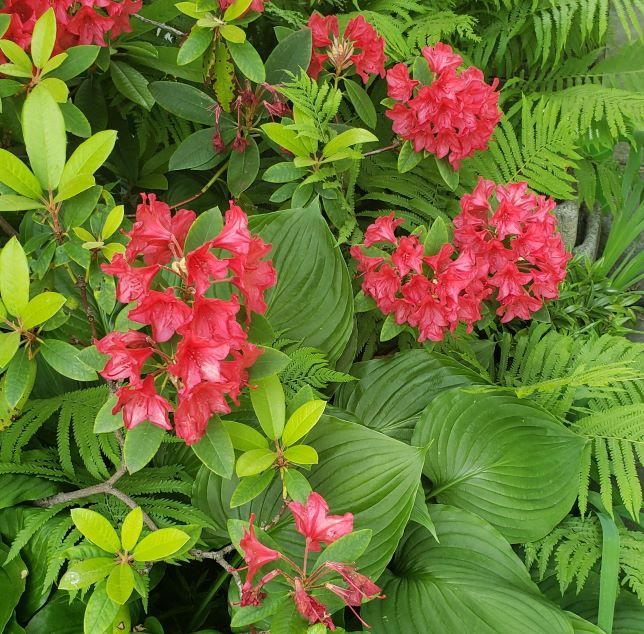Japanese style gardens emphasize simplicity and balance, incorporating a harmonious blend of trees, shrubs, grasses, and groundcovers with natural hardscaping materials. Depending on the size and style of your garden, plants may be few or may be a mixture of evergreens, deciduous trees or shrubs, and foliage perennials.
Kare Sansui, or Dry gardens will require only a few small to medium conifers in sunny areas. Chaniwa, or Tea gardens are usually enclosed and covered by tree canopy, so shade plants will predominate. Large stroll gardens will require taller trees and larger shrubs.
Flowering plants are not emphasized, so if you require a riot of color a strictly Japanese garden may not work for you. Soft, monotone color schemes will suit these designs best and allow for more blooming plants without appearing overdone. Think all white flowers with copper, black or red accents of pottery or small statuary. Shades of blue blooming plants will be offset nicely with grey or silver.
Flowering plants are most abundant in spring. Azaleas, rhododendrons, and ornamental cherries are the most common. Summer .plantings are mostly tranquil shades of green, but textural plants attract the eye and colorful foliage plants add vibrancy. Fall brings a burst of color once again as the leaves of deciduous plants like Japanese maples and dogwoods set the landscape aglow. In winter the sculptural nature of the garden is revealed as intriguing branch structures and flowing evergreen shapes are highlighted.
Consider the following plants to evoke the essence of a Japanese garden*. Click on the printable list below.
How to use this chart:
Botanical names are given along with common names, to assist in locating the correct plant. Many plants may share a common name, so without the botanical name you can not be sure which plant it is. Note that nomenclature may change as scientific study sheds new light on the relationships between plants. For example, Asters are now Symphotrichum.
Sunlight:
Sun = 6 or more hours of unobstructed sunlight.
Pt Sun = 4-6 hours of unobstructed sunlight
Shade = less than 4 hours or unobstructed sunlight or all day dappled light.
While flowering and fruiting plants may tolerate less than full sun, production will be reduced.
Water Needs:
The standard for most plants is average to moist well-drained soil--unless otherwise marked as below, this should be assumed.
Dry = Xeric conditions, extremely sandy soil, etc. An "o" in this column indicates occasional drought is tolerated. Very few plants are drought tolerant until they are established--this usually takes at least one year.
Moist = Plants that should never dry out and do not tolerate drought.
Wet = Plants that can tolerate heavily saturated soil or even standing water for a period of time. An "o" in this column indicates that occasionally wet soil is tolerated, but is otherwise well-drained.
Spread & Height is for mature plants, about 3-5 yrs for perennials and 10 yrs for shrubs/trees. The 10 year size is especially important when choosing plants and deciding siting. Conifers, especially "dwarf" conifers, are often placed in tight or space-restricted areas, and then eventually become too large for those locations. Plants don't stop growing at 10 years, so plan to begin pruning for size early if it is likely this will be needed. Plants may also grow larger or faster than average if they are really happy where they're planted, so just consider this a sign of their love for you!
*Not all plants can be recommended for all areas--they may be invasive or simply aggressive in one place but not another. Please check with your state natural resources or cooperative extension program for a list of plants that are invasive in your area.


